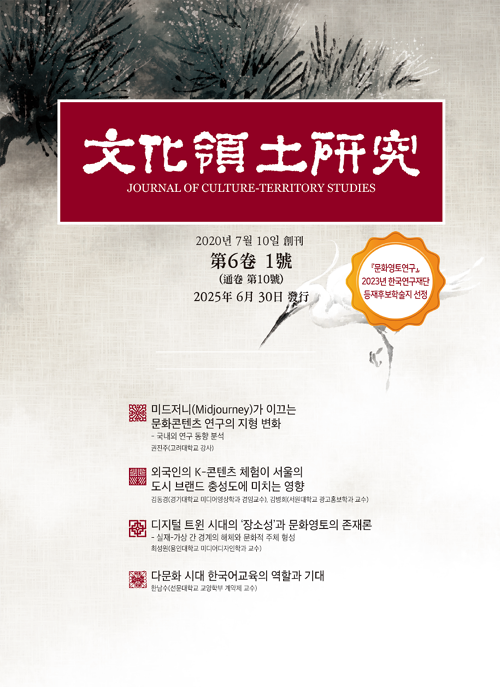- 영문명
- The Ontology of Place and Cultural Territory in the Age of Digital Twin : The Dissolution of the Real–Virtual Boundary and the Formation of Cultural Subjectivity
- 발행기관
- 재단법인 문화영토연구원
- 저자명
- 최성원(Sung-Won Choi)
- 간행물 정보
- 『문화영토연구』제6권 1호, 97~133쪽, 전체 37쪽
- 주제분류
- 인문학 > 기타인문학
- 파일형태
- 발행일자
- 2025.06.30

국문 초록
본 논문은 디지털 트윈 기술이 단순한 공간 복제 기술이 아니라, 인 간의 존재 방식과 장소 인식의 구조를 재편하는 심층적인 인문학적 전 환임을 전제로 출발한다. 디지털 트윈은 물리적 현실을 3차원 시뮬레 이션으로 재현할 뿐 아니라, 현실의 감각적 조건, 시간적 흐름, 기억의 방식, 주체의 실천을 알고리즘과 인터페이스를 통해 재구성한다. 이러 한 기술은 물리적 실재와 가상적 실재 간의 경계를 흐리게 만들며, 인 간이 세계에‘거주’하는 방식 자체에 깊이 개입하게 된다. 디지털 트 윈은 실재의 복제물이 아니라, 실재를 설계하고, 예측하고, 규율하는 새로운 기술적 존재환경으로 기능하며, 이는 궁극적으로 인간 주체성 의 형성에도 영향을 미친다.
본 연구는 하이데거의 거주 개념과 장소 존재론, 레프브르의 공간 생산 이론, 메를로퐁티의 지각 현상학, 푸코의 헤테로토피아, 보드리야르의 시뮬라크르 개념 등 다양한 현대 철학 이론들을 기반으로, 디 지털 트윈이 구성하는 공간이 과연 장소로 기능할 수 있는지를 다각도 로 검토한다. 특히 디지털 트윈은 도시계획, 문화유산 보존, 관광 콘텐 츠 개발 등 다양한 영역에서‘기억을 복제’하고‘감각을 유도’하며‘정체성을 설계’하는 방식으로 작동하고 있으며, 이 과정에서 장소 란 단순한 시각적 환경이 아니라 정치적, 문화적 권력 관계 속에서 구 성된다는 점을 밝힌다. 아울러 디지털 트윈은 사용자 몰입과 체험을 강화하는 방향으로 진화하고 있지만, 그 몰입은 설계된 알고리즘과 사 용자 동선의 통제 위에서 작동한다는 점에서 진정한 의미의 장소성과 충돌할 수 있는 잠재적 한계를 안고 있다.
또한 본 논문은 디지털 트윈 기술이 구현하는 예측 가능한 미래, 실 시간 데이터 기반의 피드백 루프, 몰입형 사용자 인터페이스 등이 인 간의 자율성과 해석 능력을 어떻게 제한하거나 구성하는지를 논의하 며, 디지털 공간이 단지 실재의 반영이 아닌 존재 조건 자체를 결정짓 는 문화기술적 장치임을 강조한다. 디지털 트윈 환경에서의 인간은 더 이상 단순한 사용자에 머물지 않으며, 시스템이 설계한 기억과 감각 구조에 따라 존재를 구성하는‘데이터 주체’로 이동하게 된다. 인간 은 디지털 공간에서 감각하고 반응하는 동시에, 기술이 허용하는 범위 내에서만 의미를 생성하고 기억을 조직하게 된다.
결론적으로 본 논문은 디지털 트윈 기술이 단지 효율성과 편의성의 도구가 아닌, 장소의 의미, 기억의 권리, 실천의 윤리성을 구성하는 핵 심적 문화장치임을 드러내며, 기술의 진보가 인간성의 진화와 어떻게 조응해야 하는가에 대한 인문학적 응답을 모색한다.
영문 초록
This study begins with the premise that digital twin technology is not merely a tool for spatial replication, but a transformative paradigm that reorganizes the structure of human existence and the perception of place. Digital twins not only simulate physical reality in three-dimensional models, but also reconstruct the conditions of perception, temporal flow, memory formation, and embodied practice through algorithms and interfaces. Such technology blurs the boundary between physical and virtual reality, deeply intervening in the very way humans“dwell”in the world. Rather than replicating reality, the digital twin functions as a new technocultural environment that designs, predicts, and regulates reality-ultimately shaping human subjectivity.
Drawing on key concepts from contemporary philosophy- Heidegger’s ontology of dwelling, Lefebvre’s theory of the production of space, Merleau-Ponty’s phenomenology of perception, Foucault’s heterotopia, and Baudrillard’s simulacra-this paper examines whether the space constituted by digital twins can truly function as a place. Particular attention is paid to how digital twins operate across domains such as urban planning, cultural heritage preservation, and immersive tourism, where they replicate memory, guide sensation, and design identity. In doing so, this study shows that place is not a neutral visual environment but a product of political and cultural power relations. While digital twins evolve to enhance user immersion and experiential interactivity, such experiences often operate under predesigned algorithms and controlled user flows, posing significant challenges to authentic placeness.
This paper further explores how predictive temporalities, real-time feedback loops, and immersive user interfaces reconfigure human autonomy and interpretive agency. The digital twin environment is presented not merely as a mirror of the real, but as a technocultural apparatus that defines the very conditions of existence. Human beings are no longer passive users, but “data subjects” whose existence is shaped within the limits of designed memories and structured perception.
In conclusion, this study calls for a humanities-based engagement within the technological interior, emphasizing that digital twins are not merely tools of efficiency and convenience, but crucial cultural devices that define the meaning of place, the right to memory, and the ethics of practice-raising essential questions about how technological progress must respond to the evolution of human identity.
목차
1. 서론
2. 이론적 고찰: 디지털 트윈 공간은 장소가 될 수 있는가
3. 디지털 트윈 기술의 구조와 문화적 응용
4. 장소성과 존재론
5. 디지털 트윈 공간의 문화영토화 조건과 한계
6. 결론
참고문헌
키워드
해당간행물 수록 논문
참고문헌
최근 이용한 논문
교보eBook 첫 방문을 환영 합니다!

신규가입 혜택 지급이 완료 되었습니다.
바로 사용 가능한 교보e캐시 1,000원 (유효기간 7일)
지금 바로 교보eBook의 다양한 콘텐츠를 이용해 보세요!


